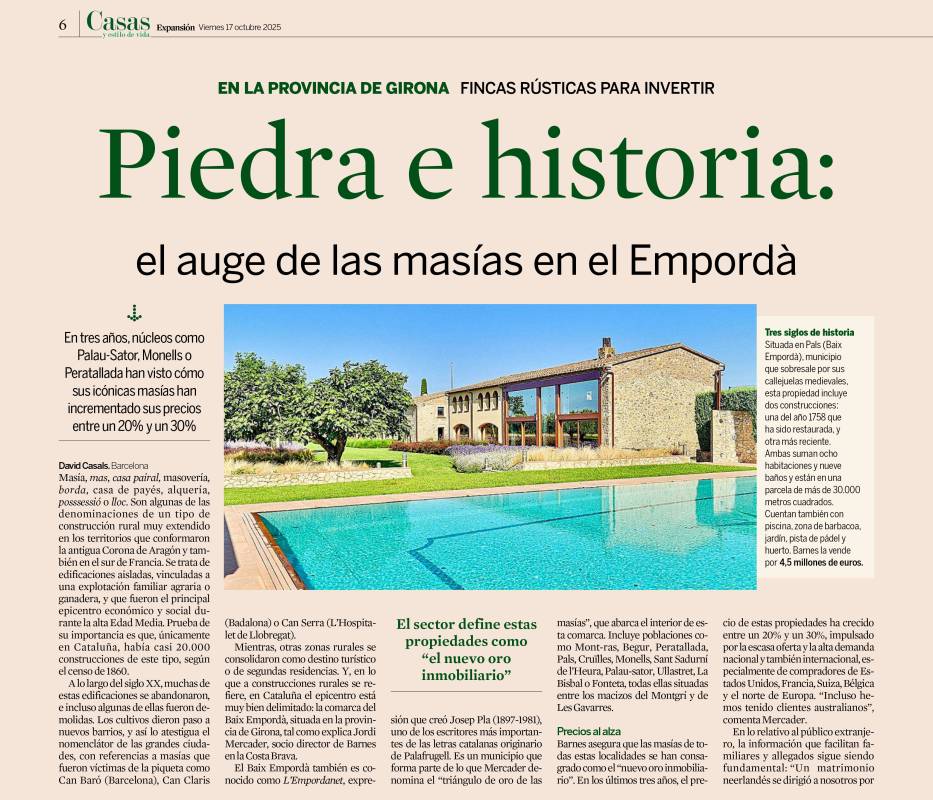


The luxury masia market in the Empordà (Girona) is in a phase of clear strength. In just three years, hubs such as Palau-sator, Monells, Peratallada, Pals, and Ullastret have recorded cumulative price increases of 20% to 30% in the best locations. This is more than a trend: it’s driven by the scarcity of heritage assets, solid international demand, and a renewed appetite for Mediterranean quality of life paired with traditional architecture.
As we have long explained at BARNES, the Baix Empordà—the “Empordanet” immortalised by Josep Pla—concentrates what we call the “golden triangle of masias”: a landscape of vineyards, holm-oak groves, and medieval villages between the Montgrí and Les Gavarres ranges, minutes from the coves and marinas of the Costa Brava. Here, stone, light, and land tell stories that span generations.
Heritage is a scarce asset. Listed masias or those with high architectural value cannot be “reproduced.” When they combine good condition, a protected environment, and swift access to the coast, the result is an asset that withstands cycles and attracts demand with a patrimonial, not speculative, mindset.
Diversified demand. Beyond domestic buyers, we see steady interest from the United States, France, Switzerland, Belgium, and Northern Europe. These are families seeking space, privacy, authenticity, and nature, with the option to work remotely and reach international airports in under 90 minutes.
Hybrid use: enjoyment + patrimony. In refurbished masias, returns are measured not only by income but also by quality of life and heritage preservation. When a property holds a tourist-use licence or a viable agro-forestry project (vineyard, olive grove, cork), it can add an operating income aligned with the place’s identity.
Architectural authenticity (stone, Catalan vaults, load-bearing walls) combined with contemporary comfort: energy efficiency, zoned climate control, discreet smart home systems, water management (wells, rainwater harvesting), and integrated solar.
Micro-location: true privacy without isolation, orientation, long views, no encumbrances, and a reasonable distance to the sea.
Legal traceability: urban status, charges and easements, land-use permissions, listed elements, and operational compatibilities.
Maintenance plan: a masia is not an apartment; it requires capex and the right vendors. A clear conservation and efficiency plan protects the asset and its future value.
Refurbishment done right. Best-in-class projects balance respect for the original with high-level technical upgrades (envelopes, insulation, joinery, underfloor heating, geo- or aerothermal systems). It’s not about “modernising” for its own sake; it’s about updating without losing the soul.
Productive landscape as added value. Cork (cork-oaks), olive groves, or small boutique winemaking reconnect the estate with its terroir and can generate complementary income.
Tourist licence and slow hospitality. In select cases, a tourist-use licence or a low-density hospitality concept (retreat, wellness, wine tourism) reinforces feasibility—always compliant with regulations and with landscape integration.
BARNES’ recent portfolio in the Baix Empordà includes refurbished masias with tourist licences near Ullastret and Mont-ras, 18th-century ensembles upgraded to efficiency standards, and large-plot properties in Pals featuring wellness areas, pools, and guest annexes. We also market newly built homes integrated into pre-existing ruins in settings like Les Gavarres, where projects recover volumes and materials with a bioclimatic approach. Two constants tie them together: identity and build quality.
Public conversation around this phenomenon is growing, and our experts are go-to voices. We have been featured in national media, including Expansión, showcasing select Empordà properties and sharing insights from Jordi Mercader, Managing Partner of BARNES Costa Brava, on the scarcity of quality stock, international traction, and the resilience of value when heritage and technical planning advance in step.
Define your “why”: family use, mixed, or patrimonial. It structures decisions (location, licences, investment).
Prioritise the envelope: efficiency and comfort reduce footprint and protect value.
Validate compatibilities: planning, heritage protection, and land-use permissions before committing capex.
Care for the landscape: Mediterranean low-consumption landscaping, water management, and respect for native species.
Exit strategy: positioning and documentation from day one. Value is also how you tell the story.
If you are considering buying a luxury masia in the Empordà or positioning your estate on the international market with maximum confidentiality, let’s talk. At BARNES Costa Brava, we combine local expertise and global reach so that stone and history translate into a sound long-term decision.
Add your comment